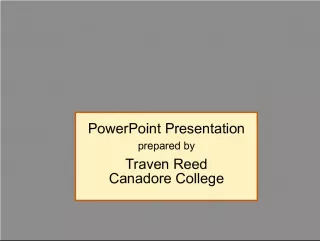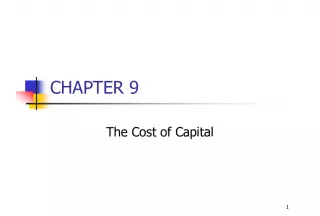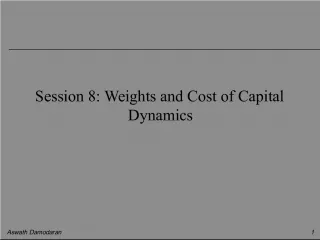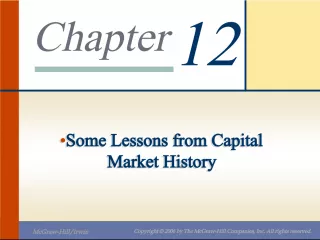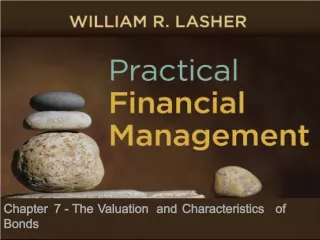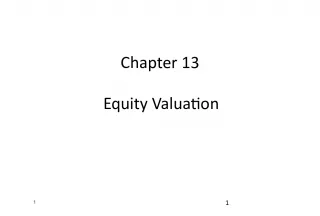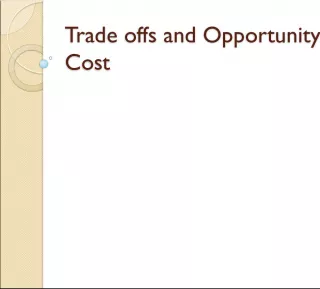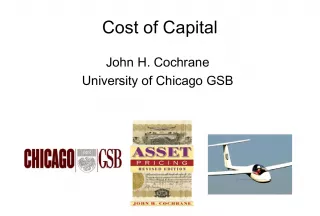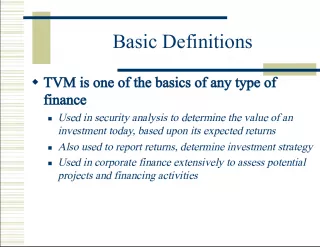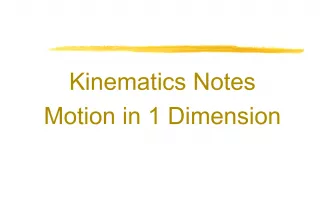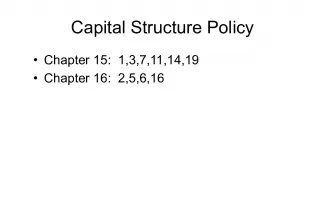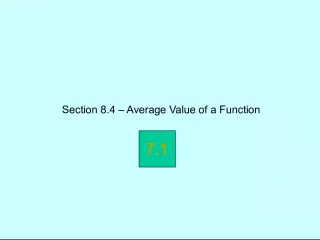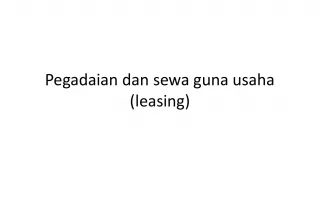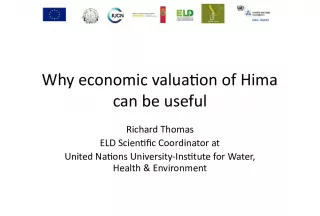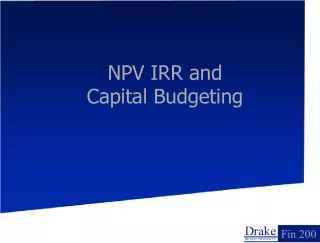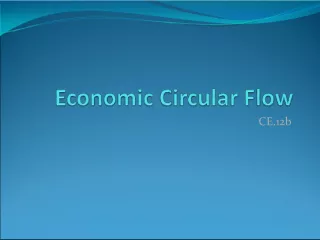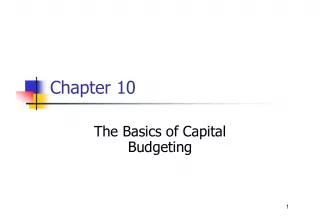Understanding Time Value of Money and Weighted Average Cost of Capital for Valuation Analysis
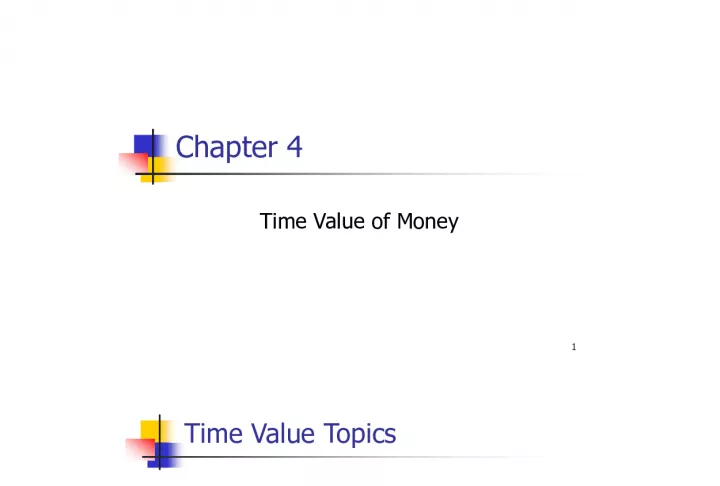

This chapter covers topics such as future and present value, rates of return, amortization, and free cash flow. It also discusses the importance of weighted average cost of capital in determining intrinsic value and presents the present value equation.
- Uploaded on | 2 Views
-
 jaydenstevens
jaydenstevens
About Understanding Time Value of Money and Weighted Average Cost of Capital for Valuation Analysis
PowerPoint presentation about 'Understanding Time Value of Money and Weighted Average Cost of Capital for Valuation Analysis'. This presentation describes the topic on This chapter covers topics such as future and present value, rates of return, amortization, and free cash flow. It also discusses the importance of weighted average cost of capital in determining intrinsic value and presents the present value equation.. The key topics included in this slideshow are . Download this presentation absolutely free.
Presentation Transcript
1. 1 Chapter 4 Time Value of Money
2. 2 Time Value Topics Future value Present value Rates of return Amortization
3. Value = + + + FCF 1 FCF 2 FCF (1 + WACC) 1 (1 + WACC) (1 + WACC) 2 Free cash flow (FCF) Cost of debt Cost of equity Weighted average cost of capital (WACC) Net operating profit after taxes Required investments in operating capital = Determinants of Intrinsic Value: The Present Value Equation ...
4. 4 Why is timing important? You are asked to choose from the following options: 1. Receive $1 million today 2. Receive $1 million 10 years from now Would you choose 1 or 2?
5. 5 Most people prefer to receive it sooner rather than later because they place a higher value on the cash received earlier. Money has time value
6. 6 Time value of money: Practical relevance Examples Retirement plan Mortgage payment Pricing a financial securities Helping your company to decide which project to undertake
7. 7 Time lines show timing of cash flows. CF 0 CF 1 CF 3 CF 2 0 1 2 3 I% Tick marks at ends of periods, so Time 0 is today; Time 1 is the end of Period 1; or the beginning of Period 2.
8. 8 Time line for a $100 lump sum due at the end of Year 2. 100 0 1 2 Year I%
9. 9 Time line for an ordinary annuity of $100 for 3 years 100 100 100 0 1 2 3 I%
10. 10 Time line for uneven CFs 100 50 75 0 1 2 3 I% -50
11. 11 Preparing BAII Plus for use Press 2nd and [Format]. The screen will display the number of decimal places that the calculator will display. If it is not eight, press 8 and then press Enter. Press 2nd and then press [P/Y]. If the display does not show one, press 1 and then Enter. Press 2nd and [BGN]. If the display is not END, that is, if it says BGN, press 2nd and then [SET], the display will read END.
12. 12 FV of an initial $100 after 3 years (I = 10%) FV = ? 0 1 2 3 10% Finding FVs (moving to the right on a time line) is called compounding. 100
13. 13 After 1 year FV 1 = PV + INT 1 = PV + PV (I) = PV(1 + I) = $100(1.10) = $110.00
14. 14 After 2 years FV 2 = FV 1 (1+I) = PV(1 + I)(1+I) = PV(1+I) 2 = $100(1.10) 2 = $121.00
15. 15 After 3 years FV 3 = FV 2 (1+I)=PV(1 + I) 2 (1+I) = PV(1+I) 3 = $100(1.10) 3 = $133.10 In general, FV N = PV(1 + I) N
16. 16 Four Ways to Find FVs Step-by-step approach using time line (as shown in Slides 12-15). Solve the equation with a regular calculator (formula approach). Use a financial calculator. Use a spreadsheet.
17. 17 Financial calculators solve this equation: FV N = PV (1+I) N There are 5 variables. If 4 are known, the calculator will solve for the 4th. Financial Calculator Solution
18. 3 10 -100 0 N I/YR PV PMT FV 133.10 INPUTS OUTPUT 18 Heres the setup to find FV
19. 19 Spreadsheet Solution Use the FV function = FV(I, N, PMT, PV) = FV(0.10, 3, 0, -100) = 133.10
20. 20 Whats the PV of $100 due in 3 years if I/YR = 10%? 10% Finding PVs is discounting, and its the reverse of compounding. 100 0 1 2 3 PV = ?
21. 21 1.10 Solve FV N = PV(1 + I ) N for PV PV = FV N (1+I) N = FV N 1 1 + I N PV = $100 1 = $100(0.7513) = $75.13 3
22. 22 Either PV or FV must be negative. Here PV = -75.13. Put in $75.13 today, take out $100 after 3 years. 3 10 0 100 N I/YR PV PMT FV -75.13 INPUTS OUTPUT Financial Calculator Solution
23. 23 Spreadsheet Solution Use the PV function: = PV(I, N, PMT, FV) = PV(0.10, 3, 0, 100) = -75.13
24. 24 20% 2 0 1 2 ? -1 Q: if deposit $1 today, and i=20%, when will it double? Finding the Time to Double
25. 25 Time to Double (Continued) $2 = $1(1 + 0.20) N (1.2) N = $2/$1 = 2 N LN(1.2) = LN(2) N = LN(2)/LN(1.2) N = 0.693/0.182 = 3.8
26. 26 20 -1 0 2 N I/YR PV PMT FV 3.8 INPUTS OUTPUT Financial Calculator Solution
27. 27 Spreadsheet Solution Use the NPER function: = NPER(I, PMT, PV, FV) = NPER(0.10, 0, -1, 2) = 3.8
28. 28 ?% 2 0 1 2 3 -1 FV = PV(1 + I) N $2 = $1(1 + I) 3 (2) (1/3) = (1 + I) 1.2599 = (1 + I) I = 0.2599 = 25.99% Finding the interest rate
29. 29 3 -1 0 2 N I/YR PV PMT FV 25.99 INPUTS OUTPUT Financial Calculator
30. 30 Spreadsheet Solution Use the RATE function: = RATE(N, PMT, PV, FV) = RATE(3, 0, -1, 2) = 0.2599
31. 31 Exercises Suppose you deposit $150 in an account today and the interest rate is 6 percent p.a.. How much will you have in the account at the end of 33 years? You deposited $15,000 in an account 22 years ago and now the account has $50,000 in it. What was the annual rate of return that you received on this investment? You currently have $38,000 in an account that has been paying 5.75 percent p.a.. You remember that you had opened this account quite some years ago with an initial deposit of $19,000. You forget when the initial deposit was made. How many years (in fractions) ago did you make the initial deposit?
32. 32 Perpetuity 1 Perpetuity: a stream of equal cash flows ( C ) that occur at the end of each period and go on forever. PV of perpetuity =
33. 33 Perpetuity 2 We use the idea of a perpetuity to determine the value of A preferred stock A perpetual debt
34. 34 Perpetuity questions Suppose the value of a perpetuity is $38,900 and the discount rate is 12 percent p.a.. What must be the annual cash flow from this perpetuity? Verify that C = $4,668. An asset that generates $890 per year forever is priced at $6,000. What is the required rate of return? Verify that r = 14.833 %
35. 35 Ordinary Annuity Ordinary annuity: a cash flow stream where a fixed amount is received at the end of every period for a fixed number of periods.
36. 36 Whats the FV of a 3-year ordinary annuity of $100 at 10%? 100 100 100 0 1 2 3 10% 110 121 FV = 331
37. 37 Have payments but no lump sum PV, so enter 0 for present value. 3 10 0 -100 331.00 N I/YR PMT FV PV INPUTS OUTPUT Financial Calculator Solution
38. 38 Spreadsheet Solution Use the FV function: = FV(I, N, PMT, PV) = FV(0.10, 3, -100, 0) = 331.00
39. 39 Whats the PV of this ordinary annuity? 100 100 100 0 1 2 3 10% 90.91 82.64 75.13 248.69 = PV
40. 40 Have payments but no lump sum FV, so enter 0 for future value. 3 10 100 0 N I/YR PV PMT FV -248.69 INPUTS OUTPUT Financial Calculator Solution
41. 41 Spreadsheet Solution Use the PV function: = PV(I, N, PMT, FV) = PV(0.10, 3, 100, 0) = -248.69
42. 42 Annuity, find FV You open an account today with $20,000 and at the end of each of the next 15 years, you deposit $2,500 in it. At the end of 15 years, what will be the balance in the account if the interest rate is 7 percent p.a.? PV=-20000, PMT=-2500, N=15, I/Y=7, FV=?
43. 43 Annuity, find I/Y You lend your friend $100,000. He will pay you $12,000 per year for the ten years and a balloon payment at t = 10 of $50,000. What is the interest rate that you are charging your friend? PV=-100,000, FV=50,000, PMT=12,000, N = 10, I/Y=?
44. 44 Annuity, find PMT Next year, you will start to make 35 deposits of $3,000 per year in your Individual Retirement Account (so you will contribute from t=1 to t=35). With the money accumulated at t=35, you will then buy a retirement annuity of 20 years with equal yearly payments from a life insurance company (payments from t=36 to t=55). If the annual rate of return over the entire period is 8%, what will be the annual payment of the annuity?
45. 45 Annuity Due Annuity due: a cash flow stream where a fixed amount is received at the beginning of every period for a fixed number of periods.
46. 46 Ordinary Annuity PMT PMT PMT 0 1 2 3 I% PMT PMT 0 1 2 3 I% PMT Annuity Due Ordinary Annuity vs. Annuity Due
47. 47 Ordinary Annuity vs. Annuity Due T = 0 $300 T = 1 $300 $300 T = 2 T = 3 T = 0 T = 1 $300 T = 2 T = 3 $300 $300
48. 48 a relationship between ordinary annuity and annuity due? PV of annuity due = (PV of ordinary annuity) x (1 + r) FV of annuity due = (FV of ordinary annuity) x (1 + r)
49. 49 Find the FV and PV if the annuity were an annuity due. 100 100 0 1 2 3 10% 100
50. 50 PV and FV of Annuity Due vs. Ordinary Annuity PV of annuity due: = (PV of ordinary annuity) (1+I) = ($248.69) (1+ 0.10) = $273.56 FV of annuity due: = (FV of ordinary annuity) (1+I) = ($331.00) (1+ 0.10) = $364.10
51. 51 PV of Annuity Due: Switch from End to Begin 3 10 100 0 -273.55 N I/YR PV PMT FV INPUTS OUTPUT BEGIN Mode
52. 52 FV of Annuity Due: Switch from End to Begin 3 10 0 100 -364.10 N I/YR PV PMT FV INPUTS OUTPUT BEGIN Mode
53. 53 Excel Function for Annuities Due Change the formula to: =PV(0.10,3,-100,0,1) The fourth term, 0, tells the function there are no other cash flows. The fifth term tells the function that it is an annuity due. A similar function gives the future value of an annuity due: =FV(0.10,3,-100,0,1)
54. 54 What is the PV of this uneven cash flow stream? 0 100 1 300 2 300 3 10% -50 4 90.91 247.93 225.39 -34.15 530.08 = PV
55. Solving with Calculator Input cash flows in the calculators CF register: Press CF key CF 0 = 0, ENTER, C01 = 100, ENTER, F01=1, ENTER, C02 = 300, ENTER, F02=2, ENTER, C03= 50, +/- key, ENTER, F03=1, ENTER, Press NPV key, I = 10, ENTER, press CPT key to get NPV = 530.087. (Here NPV = PV.) 55
56. 56 Excel Formula in cell A3: =NPV(10%,B2:E2)
57. 57 In-class group project You will need to pay for your sons private school tuition (first grade through 12th grade) a sum of $8,000 per year for Years 1 through 5, $10,000 per year for Years 6 through 8, and $12,500 per year for Years 9 through 12. Assume that all payments are made at the beginning of the year, that is, tuition for Year 1 is paid now (i.e., at t = 0), tuition for Year 2 is paid one year from now, and so on. In addition to the tuition payments you expect to incur graduation expenses of $2,500 at the end of Year 12. If a bank account can provide a certain 10 percent p.a. rate of return, how much money do you need to deposit today to be able to pay for the above expenses?
58. 58 Nominal rate (I NOM ) Stated in contracts, and quoted by banks and brokers. Not used in calculations or shown on time lines Periods per year (M) must be given. Examples: 8%; Quarterly 8%, Daily interest (365 days)
59. 59 Periodic rate (I PER ) I PER = I NOM /M, where M is number of compounding periods per year. M = 4 for quarterly, 12 for monthly, and 360 or 365 for daily compounding. Used in calculations, shown on time lines. Examples: 8% quarterly: I PER = 8%/4 = 2%. 8% daily (365): I PER = 8%/365 = 0.021918%.
60. 60 The Impact of Compounding Will the FV of a lump sum be larger or smaller if we compound more often, holding the stated I% constant? Why?
61. 61 The Impact of Compounding (Answer) LARGER! If compounding is more frequent than once a year--for example, semiannually, quarterly, or daily--interest is earned on interest more often.
62. 62 Common examples Compounding period Compounding frequency Six-months / semiannual 2 Quarter 4 Month 12 Day 365
63. 63 When frequency of compounding is more than once a year n = number of years m = frequency of compounding per year r = nominal rate
64. 64 Effective Annual Rate (EAR = EFF%) The EAR is the annual rate that causes PV to grow to the same FV as under multi-period compounding.
65. 65 Effective Annual Rate Example Example: Invest $1 for one year at 12%, semiannual: FV = PV(1 + I NOM /M) M FV = $1 (1.06) 2 = $1.1236. EFF% = 12.36%, because $1 invested for one year at 12% semiannual compounding would grow to the same value as $1 invested for one year at 12.36% annual compounding.
66. 66 $100 at a 12% nominal rate with semiannual compounding for 5 years = $100(1.06) 10 = $179.08 I NOM FV N = PV 1 + M M N 0.12 FV 5S = $100 1 + 2 2x5
67. 67 FV of $100 at a 12% nominal rate for 5 years with different compounding FV(Ann.) = $100(1.12) 5 = $176.23 FV(Semi.) = $100(1.06) 10 = $179.08 FV(Quar.) = $100(1.03) 20 = $180.61 FV(Daily) = $100(1+(0.12/365)) (5x365) = $182.19 How to solve with financial calculator?
68. 68 Comparing Rates An investment with monthly payments is different from one with quarterly payments. Must put on EFF% basis to compare rates of return. Use EFF% only for comparisons. Banks say interest paid daily. Same as compounded daily.
69. 69 EFF% = 1 + 1 I NOM M M EFF% for a nominal rate of 12%, compounded semiannually = 1 + 1 0.12 2 2 = (1.06) 2 - 1.0 = 0.1236 = 12.36%.
70. 70 EAR (or EFF%) for a Nominal Rate of of 12% EAR Annual = 12%. EAR Q = (1 + 0.12/4) 4 - 1 = 12.55%. EAR M = (1 + 0.12/12) 12 - 1 = 12.68%. EAR D(365) = (1 + 0.12/365) 365 - 1= 12.75%.
71. 71 Can the effective rate ever be equal to the nominal rate? Yes, but only if annual compounding is used, i.e., if M = 1. If M > 1, EFF% will always be greater than the nominal rate.
72. 72 When is each rate used? I NOM : Written into contracts, quoted by banks and brokers. Not used in calculations or shown on time lines.
73. 73 I PER : Used in calculations, shown on time lines. If I NOM has annual compounding, then I PER = I NOM /1 = I NOM . When is each rate used? (Continued)
74. 74 When is each rate used? (Continued) EAR (or EFF%): Used to compare returns on investments with different payments per year. Used for calculations if and only if dealing with annuities where payments dont match interest compounding periods.
75. 75 Annuity with semiannual compounding You would like to accumulate $16,500 over the next 8 years. How much must you deposit every six months, starting six months from now, given a 4 percent per annum rate with semiannual compounding?
76. 76 Loan Amortization Amortization is the process of separating a payment into interest payment and repayment of principal. Amortization schedule is a table that shows how each payment is split into principal repayment and interest payment.
77. 77 Amortization Example 1 Construct an amortization schedule for a $1,000, 10% annual rate loan with 3 equal payments.
78. PMT PMT PMT 0 1 2 3 10% -1,000 3 10 -1000 0 INPUTS OUTPUT N I/Y R PV FV PMT 402.11 78 Step 1: Find the required payments.
79. 79 Step 2: Find interest charge for Year 1. INT t = Beg bal t (I) INT 1 = $1,000(0.10) = $100
80. 80 Repmt = PMT - INT = $402.11 - $100 = $302.11 Step 3: Find repayment of principal in Year 1.
81. 81 Step 4: Find ending balance after Year 1. End bal = Beg bal - Repmt = $1,000 - $302.11 = $697.89 Repeat these steps for Years 2 and 3 to complete the amortization table.
82. 82 Amortization Table YEAR BEG BAL PMT INT PRIN PMT END BAL 1 $1,000 $402 $100 $302 $698 2 698 402 70 332 366 3 366 402 37 366 0 TOT 1,206.34 206.34 1,000
83. 83 Interest declines because outstanding balance declines.
84. 84 Amortization tables are widely used--for home mortgages, auto loans, business loans, retirement plans, and more. They are very important!
85. 85 Example of loan amortization 1 You have borrowed $8,000 from a bank and have promised to repay the loan in five equal yearly payments. The first payment is at the end of the first year. The interest rate is 10 percent. Draw up the amortization schedule for this loan.
86. 86 Example of loan amortization 2 1) Compute periodic payment. PV=8000, N=5, I/Y=10, FV=0, PMT=? Verify that PMT = - 2,110.38
87. 87 Example of loan amortization 3 Suppose we want to work out the remaining balance immediately after the 2 nd payment. Press [2ND], [AMORT] to activate the Amortization worksheet in BA II Plus. Press P1=2, [ENTER], , Press P2=2, [ENTER], , You will see BAL=5,248.20
88. 88 Press again and you see the portion of the year 2 payment going towards repaying principal, PRN = -1,441.42 Press again and you see the portion of year 2 payment going towards interest, INT = -668.96 To get out of the Amortization schedule, press [2ND], Quit. Example of loan amortization 4
89. 89 Verify the amortization schedule Year Beg. Balance Payment Interest Principal End. Balance 0 8,000.00 1 8,000.00 2,110.38 800.00 1,310.38 6,689.62 2 6689.62 2,110.38 668.96 1,441.42 5,248.20 3 5248.20 2,110.38 524.82 1,585.56 3,662.64 4 3662.64 2,110.38 366.26 1,744.12 1,918.53 5 1918.53 2,110.38 191.85 1,918.53 0.00
90. 90 Non-matching rates and periods Whats the value at the end of Year 3 of the following CF stream if the quoted interest rate is 10%, compounded semiannually?
91. 91 Time line for non-matching rates and periods 0 1 100 2 3 5% 4 5 6 6-mos. periods 100 100
92. 92 Non-matching rates and periods Payments occur annually, but compounding occurs each 6 months. So we cant use normal annuity valuation techniques.
93. 93 1st Method: Compound Each CF 0 1 100 2 3 5% 4 5 6 100 100.00 110.25 121.55 331.80 FVA 3 = $100(1.05) 4 + $100(1.05) 2 + $100 = $331.80
94. 94 2nd Method: Treat as an annuity, use financial calculator Find the EFF% (EAR) for the quoted rate: EFF% = 1 + 1 = 10.25% 0.10 2 2
95. 95 3 10.25 0 -100 INPUTS OUTPUT N I/YR PV FV PMT 331.80 Use EAR = 10.25% as the annual rate in calculator.
96. 96 Whats the PV of this stream? 0 100 1 5% 2 3 100 100 90.70 82.27 74.62 247.59
97. 97 3 10.25 -100 0 INPUTS OUTPUT N I/YR PV FV PMT 247.59 Whats the PV of this stream? EAR = 10.25%
98. 98 After Chapter Homework Problems: 1- 25, 27-30.
